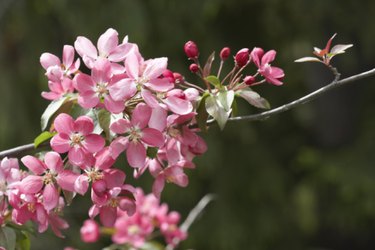
Prunus subhirtella is the botanical name for the weeping cherry tree, also called the weeping Higan cherry. As the name suggests, this type of cherry tree has drooping branches that lend an air of soothing grace to the landscape. Certain pests and disease pathogens can cause the leaves on this ornamental fruit tree to turn brown and curl. Prompt diagnosis and treatment helps protect the appearance and the health of weeping cherries.
Pests
Video of the Day
Weeping cherries are prone to certain pest infestations, including scales, mites, caterpillars, borers, leaf rollers and aphids. The ones most likely to cause curling and discoloration of leaves are aphids and leaf rollers. Aphids damage the foliage by injecting a substance into the leaves that allows them to suck out the juices they ingest. This substance makes the leaves curl, protecting the feeding aphids from wind and rain. Leaf rollers are moth larvae that feed on the fruit, flowers and leaves of numerous fruit trees, including weeping cherries. In addition to leaf damage, these pests cause holes in fruit and wilted blossoms. Insecticides can reduce the population of these pests, although aphids may disappear without treatment, as area predators feed on these insects.
Video of the Day
Disease
Bacterium diseases that cause leaf spotting can make the leaves brown and curl, eventually causing them to drop from the tree. Fungal conditions can also discolor and curl the leaves of weeping cherries. Other symptoms may include the appearance of small holes in the leaves and damaged leaves that have a reddish hue.
Treatments
The best time to treat weeping cherries for leaf rollers is in the springtime, between the times of late bloom to petal fall. Stubborn infestations may require a second application during the middle of summer. Treating the trees early in the blooming season may kill the beneficial insects that pollinate weeping cherries, minimizing the production of fruit for the season. Removing damaged branches and thinning out the canopy will minimize bacterial and fungal growth. Fungicide sprays and soil drenches can eliminate fungal disorders.
Preventative Measures
Eliminate the cause of leaf damage on weeping cherries by keeping your tree healthy. Proper care helps this plant withstand pest infestations and disease pathogens. Grow this tree in a sunny location with well-drained soil. Water this tree during extended droughts, keeping the soil slightly moist near the roots. Ward off nutritional deficiencies by feeding a weeping cherry monthly during the spring and summer seasons.